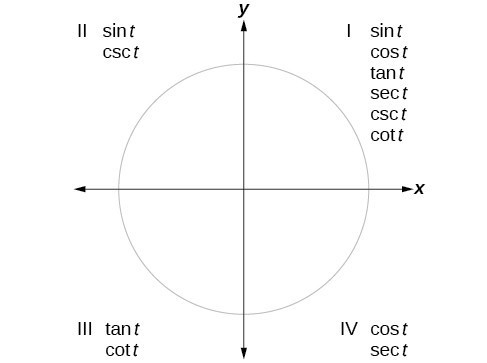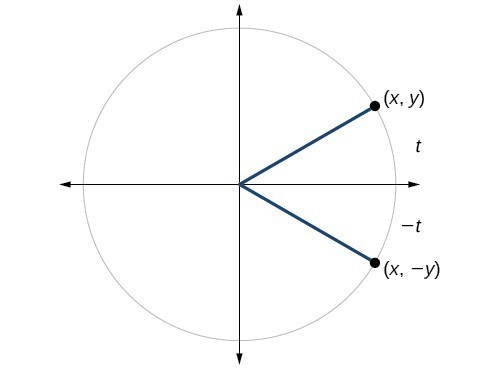Learning Outcomes
- Find exact values of the trigonometric functions secant, cosecant, tangent, and cotangent of 30° (π/6), 45° (π/4), and 60° (π/3).
- Use reference angles to evaluate the trigonometric functions secant, cosecant, tangent, and cotangent.
- Use properties of even and odd trigonometric functions.
- Recognize and use fundamental identities.
- Evaluate trigonometric functions with a calculator.
Find exact values of the trigonometric functions secant, cosecant, tangent, and cotangent
To define the remaining functions, we will once again draw a unit circle with a point [latex]\left(x,y\right)[/latex] corresponding to an angle of [latex]t[/latex], as shown in Figure 1. As with the sine and cosine, we can use the [latex]\left(x,y\right)[/latex] coordinates to find the other functions.

Figure 1
The first function we will define is the tangent. The tangent of an angle is the ratio of the y-value to the x-value of the corresponding point on the unit circle. In Figure 1, the tangent of angle [latex]t[/latex] is equal to [latex]\frac{y}{x},x\ne 0[/latex]. Because the y-value is equal to the sine of [latex]t[/latex], and the x-value is equal to the cosine of [latex]t[/latex], the tangent of angle [latex]t[/latex] can also be defined as [latex]\frac{\sin t}{\cos t},\cos t\ne 0[/latex]. The tangent function is abbreviated as [latex]\tan[/latex]. The remaining three functions can all be expressed as reciprocals of functions we have already defined.
- The secant function is the reciprocal of the cosine function. In Figure 1, the secant of angle [latex]t[/latex] is equal to [latex]\frac{1}{\cos t}=\frac{1}{x},x\ne 0[/latex]. The secant function is abbreviated as [latex]\sec[/latex].
- The cotangent function is the reciprocal of the tangent function. In Figure 1, the cotangent of angle [latex]t[/latex] is equal to [latex]\frac{\cos t}{\sin t}=\frac{x}{y},y\ne 0[/latex]. The cotangent function is abbreviated as [latex]\cot[/latex].
- The cosecant function is the reciprocal of the sine function. In Figure 1, the cosecant of angle [latex]t[/latex] is equal to [latex]\frac{1}{\sin t}=\frac{1}{y},y\ne 0[/latex]. The cosecant function is abbreviated as [latex]\csc[/latex].
A General Note: Tangent, Secant, Cosecant, and Cotangent Functions
If [latex]t[/latex] is a real number and [latex]\left(x,y\right)[/latex] is a point where the terminal side of an angle of [latex]t[/latex] radians intercepts the unit circle, then
[latex]\begin{gathered}\tan t=\frac{y}{x},x\ne 0\\ \sec t=\frac{1}{x},x\ne 0\\ \csc t=\frac{1}{y},y\ne 0\\ \cot t=\frac{x}{y},y\ne 0\end{gathered}[/latex]
Example 1: Finding Trigonometric Functions from a Point on the Unit Circle
The point [latex]\left(-\frac{\sqrt{3}}{2},\frac{1}{2}\right)[/latex] is on the unit circle, as shown in Figure 2. Find [latex]\sin t,\cos t,\tan t,\sec t,\csc t[/latex], and [latex]\cot t[/latex].

Figure 2
Try It
The point [latex]\left(\frac{\sqrt{2}}{2},-\frac{\sqrt{2}}{2}\right)[/latex] is on the unit circle, as shown in Figure 3. Find [latex]\sin t,\cos t,\tan t,\sec t,\csc t[/latex], and [latex]\cot t[/latex].

Figure 3
Example 2: Finding the Trigonometric Functions of an Angle
Find [latex]\sin t,\cos t,\tan t,\sec t,\csc t[/latex], and [latex]\cot t[/latex] when [latex]t=\frac{\pi }{6}[/latex].
Try It
Find [latex]\sin t,\cos t,\tan t,\sec t,\csc t[/latex], and [latex]\cot t[/latex] when [latex]t=\frac{\pi }{3}[/latex].
Try It
Because we know the sine and cosine values for the common first-quadrant angles, we can find the other function values for those angles as well by setting [latex]x[/latex] equal to the cosine and [latex]y[/latex] equal to the sine and then using the definitions of tangent, secant, cosecant, and cotangent. The results are shown in the table below.
| Angle | [latex]0[/latex] | [latex]\frac{\pi }{6},\text{ or }{30}^{\circ}[/latex] | [latex]\frac{\pi }{4},\text{ or } {45}^{\circ }[/latex] | [latex]\frac{\pi }{3},\text{ or }{60}^{\circ }[/latex] | [latex]\frac{\pi }{2},\text{ or }{90}^{\circ }[/latex] |
| Cosine | 1 | [latex]\frac{\sqrt{3}}{2}[/latex] | [latex]\frac{\sqrt{2}}{2}[/latex] | [latex]\frac{1}{2}[/latex] | 0 |
| Sine | 0 | [latex]\frac{1}{2}[/latex] | [latex]\frac{\sqrt{2}}{2}[/latex] | [latex]\frac{\sqrt{3}}{2}[/latex] | 1 |
| Tangent | 0 | [latex]\frac{\sqrt{3}}{3}[/latex] | 1 | [latex]\sqrt{3}[/latex] | Undefined |
| Secant | 1 | [latex]\frac{2\sqrt{3}}{3}[/latex] | [latex]\sqrt{2}[/latex] | 2 | Undefined |
| Cosecant | Undefined | 2 | [latex]\sqrt{2}[/latex] | [latex]\frac{2\sqrt{3}}{3}[/latex] | 1 |
| Cotangent | Undefined | [latex]\sqrt{3}[/latex] | 1 | [latex]\frac{\sqrt{3}}{3}[/latex] | 0 |
Using Reference Angles to Evaluate Tangent, Secant, Cosecant, and Cotangent
We can evaluate trigonometric functions of angles outside the first quadrant using reference angles as we have already done with the sine and cosine functions. The procedure is the same: Find the reference angle formed by the terminal side of the given angle with the horizontal axis. The trigonometric function values for the original angle will be the same as those for the reference angle, except for the positive or negative sign, which is determined by x– and y-values in the original quadrant. Figure 4 shows which functions are positive in which quadrant.
To help us remember which of the six trigonometric functions are positive in each quadrant, we can use the mnemonic phrase “A Smart Trig Class.” Each of the four words in the phrase corresponds to one of the four quadrants, starting with quadrant I and rotating counterclockwise. In quadrant I, which is “A,” all of the six trigonometric functions are positive. In quadrant II, “Smart,” only sine and its reciprocal function, cosecant, are positive. In quadrant III, “Trig,” only tangent and its reciprocal function, cotangent, are positive. Finally, in quadrant IV, “Class,” only cosine and its reciprocal function, secant, are positive.

Figure 4
How To: Given an angle not in the first quadrant, use reference angles to find all six trigonometric functions.
- Measure the angle formed by the terminal side of the given angle and the horizontal axis. This is the reference angle.
- Evaluate the function at the reference angle.
- Observe the quadrant where the terminal side of the original angle is located. Based on the quadrant, determine whether the output is positive or negative.
Example 3: Using Reference Angles to Find Trigonometric Functions
Use reference angles to find all six trigonometric functions of [latex]-\frac{5\pi }{6}[/latex].
Try It
Use reference angles to find all six trigonometric functions of [latex]-\frac{7\pi }{4}[/latex].
Try It
Using Even and Odd Trigonometric Functions
To be able to use our six trigonometric functions freely with both positive and negative angle inputs, we should examine how each function treats a negative input. As it turns out, there is an important difference among the functions in this regard.
Consider the function [latex]f\left(x\right)={x}^{2}[/latex], shown in Figure 5. The graph of the function is symmetrical about the y-axis. All along the curve, any two points with opposite x-values have the same function value. This matches the result of calculation: [latex]{\left(4\right)}^{2}={\left(-4\right)}^{2}[/latex], [latex]{\left(-5\right)}^{2}={\left(5\right)}^{2}[/latex], and so on. So [latex]f\left(x\right)={x}^{2}[/latex] is an even function, a function such that two inputs that are opposites have the same output. That means [latex]f\left(-x\right)=f\left(x\right)[/latex].

Figure 5. The function [latex]f\left(x\right)={x}^{2}[/latex] is an even function.
Now consider the function [latex]f\left(x\right)={x}^{3}[/latex], shown in Figure 6. The graph is not symmetrical about the y-axis. All along the graph, any two points with opposite x-values also have opposite y-values. So [latex]f\left(x\right)={x}^{3}[/latex] is an odd function, one such that two inputs that are opposites have outputs that are also opposites. That means [latex]f\left(-x\right)=-f\left(x\right)[/latex].

Figure 6. The function [latex]f\left(x\right)={x}^{3}[/latex] is an odd function.
We can test whether a trigonometric function is even or odd by drawing a unit circle with a positive and a negative angle, as in Figure 7. The sine of the positive angle is [latex]y[/latex]. The sine of the negative angle is −y. The sine function, then, is an odd function. We can test each of the six trigonometric functions in this fashion. The results are shown in in the table below.

Figure 7
| [latex]\begin{array}{l}\sin t=y\hfill \\ \sin \left(-t\right)=-y\hfill \\ \sin t\ne \sin \left(-t\right)\hfill \end{array}[/latex] | [latex]\begin{array}{l}\text{cos}t=x\hfill \\ \cos \left(-t\right)=x\hfill \\ \cos t=\cos \left(-t\right)\hfill \end{array}[/latex] | [latex]\begin{array}{l}\text{tan}\left(t\right)=\frac{y}{x}\hfill \\ \tan \left(-t\right)=-\frac{y}{x}\hfill \\ \tan t\ne \tan \left(-t\right)\hfill \end{array}[/latex] |
| [latex]\begin{array}{l}\sec t=\frac{1}{x}\hfill \\ \sec \left(-t\right)=\frac{1}{x}\hfill \\ \sec t=\sec \left(-t\right)\hfill \end{array}[/latex] | [latex]\begin{array}{l}\csc t=\frac{1}{y}\hfill \\ \csc \left(-t\right)=\frac{1}{-y}\hfill \\ \csc t\ne \csc \left(-t\right)\hfill \end{array}[/latex] | [latex]\begin{array}{l}\cot t=\frac{x}{y}\hfill \\ \cot \left(-t\right)=\frac{x}{-y}\hfill \\ \cot t\ne cot\left(-t\right)\hfill \end{array}[/latex] |
A General Note: Even and Odd Trigonometric Functions
An even function is one in which [latex]f\left(-x\right)=f\left(x\right)[/latex].
An odd function is one in which [latex]f\left(-x\right)=-f\left(x\right)[/latex].
Cosine and secant are even:
[latex]\begin{gathered}\cos \left(-t\right)=\cos t \\ \sec \left(-t\right)=\sec t \end{gathered}[/latex]
Sine, tangent, cosecant, and cotangent are odd:
[latex]\begin{gathered}\sin \left(-t\right)=-\sin t \\ \tan \left(-t\right)=-\tan t \\ \csc \left(-t\right)=-\csc t \\ \cot \left(-t\right)=-\cot t \end{gathered}[/latex]
Example 4: Using Even and Odd Properties of Trigonometric Functions
If the [latex]\sec t=2[/latex], what is the [latex]\sec (-t)[/latex]?
Try It
If the [latex]\cot t=\sqrt{3}[/latex], what is [latex]\cot (-t)[/latex]?
Recognize and Use Fundamental Identities
We have explored a number of properties of trigonometric functions. Now, we can take the relationships a step further, and derive some fundamental identities. Identities are statements that are true for all values of the input on which they are defined. Usually, identities can be derived from definitions and relationships we already know. For example, the Pythagorean Identity we learned earlier was derived from the Pythagorean Theorem and the definitions of sine and cosine.
A General Note: Fundamental Identities
We can derive some useful identities from the six trigonometric functions. The other four trigonometric functions can be related back to the sine and cosine functions using these basic relationships:
[latex]\tan t=\frac{\sin t}{\cos t}[/latex]
[latex]\sec t=\frac{1}{\cos t}[/latex]
[latex]\csc t=\frac{1}{\sin t}[/latex]
[latex]\cot t=\frac{1}{\tan t}=\frac{\cos t}{\sin t}[/latex]
Example 5: Using Identities to Evaluate Trigonometric Functions
- Given [latex]\sin \left(45^\circ \right)=\frac{\sqrt{2}}{2},\cos \left(45^\circ \right)=\frac{\sqrt{2}}{2}[/latex], evaluate [latex]\tan \left(45^\circ \right)[/latex].
- Given [latex]\sin \left(\frac{5\pi }{6}\right)=\frac{1}{2},\cos\left(\frac{5\pi }{6}\right)=-\frac{\sqrt{3}}{2}[/latex], evaluate [latex]\sec \left(\frac{5\pi }{6}\right)[/latex].
Try It
Evaluate [latex]\csc\left(\frac{7\pi }{6}\right)[/latex].
Example 6: Using Identities to Simplify Trigonometric Expressions
Simplify [latex]\frac{\sec t}{\tan t}[/latex].
Try It
Simplify [latex]\tan t\left(\cos t\right)[/latex].
Alternate Forms of the Pythagorean Identity
We can use these fundamental identities to derive alternative forms of the Pythagorean Identity, [latex]{\cos }^{2}t+{\sin }^{2}t=1[/latex]. One form is obtained by dividing both sides by [latex]{\cos }^{2}t:[/latex]
The other form is obtained by dividing both sides by [latex]{\sin }^{2}t:[/latex]
A General Note: Alternate Forms of the Pythagorean Identity
[latex]1+{\tan }^{2}t={\sec }^{2}t[/latex]
[latex]{\cot }^{2}t+1={\csc }^{2}t[/latex]
Example 7: Using Identities to Relate Trigonometric Functions
If [latex]\text{cos}\left(t\right)=\frac{12}{13}[/latex] and [latex]t[/latex] is in quadrant IV, as shown in Figure 8, find the values of the other five trigonometric functions.

Figure 8
Try It
If [latex]\sec \left(t\right)=-\frac{17}{8}[/latex] and [latex]0

